Do higher end subwoofer cables make for a sound quality improvement?
- Thread starter Lee
- Start date
You are using an out of date browser. It may not display this or other websites correctly.
You should upgrade or use an alternative browser.
You should upgrade or use an alternative browser.
Two rounds of experimenting. I purchased the Vandersteen subs a couple years ago and experimented with cables a few months after installation. I purchased the Perlisten subs within the last six months and experimented with cables relatively recently. I’m pretty darn thrilled with the combo, especially how they enhance recordings that I had previously perceived as sounding thin/lethargic. The ability to knock down substantial room mode peaks to just a few dB using the integrated EQ is very effective and led to the ol’ subwoofer disappearing act in my room.I would have to double check, but I don't think so.
Question for ya'....did you do a PC/IC swap out for all 4 at the same time or with just 2 subs?
Tom
I am using EQ. I run a Lyngdorf and as such use RoomPerfect. Like you describe I also have a nice flat response achieved by RoomPerfect.Question: Are folks with really nice subwoofer setups using or not using EQ for the lows?
I have used EQ for over a decade with my various subs and once I heard the impact of early day manual EQ systems, there was no going back.
The modern day automated systems are great, but most target the frequency response only, whereas RoomPerfect works differently and prioritises power output if the speaker and as such does not change the sound of your speaker to fit the EQ system target curve. I have Anthem EQ in our family room and while that is also good, it does tend to push more towards the Anthem sound and as such took a lot is tweaking.
No EQ or DSP on my end, I have played with it and yes it can do wonders in some cases (I run DiracLive in my office) but nothing on the main system, I have played with Roon and REW and Dirac and reached the following conclusion, if you can get away without any shaping it's preferred but if needed EQ's is the lesser evils, DSP is great if you like a sound and like a genre but if you jump all over it's a nuisance.I posted above that I did not perceive benefits to overall sound quality from using finer signal and power cables to my four subwoofers, comprising two Vandersteen Sub Three placed near the main speakers and two Perlisten R212s placed near the rear room corners. It appears several folks perceive benefits.
I use first-order filters (6 dB per octave slope) to high-pass to the mains and low-pass to the subwoofers with a cutoff frequency of 80 Hz. Also, I use liberally the multi-band EQ integrated in each subwoofer to mostly cut room mode peaks, leading to in-room bass response measured at the listener position that is +/- 3dB (6dB peak to trough) between 20 Hz and 150 Hz - pretty smooth. The Vandersteen subwoofers also provide for variable Q adjustment impacting the perception of damped/tight versus warm/loose bass quality. I suspect the influence of EQ and Q adjustability in my setup impacted my assessment of benefits from using finer signal and power cables.
Question: Are folks with really nice subwoofer setups using or not using EQ for the lows?
Small disclaimer, I am all for using a EQ as a filter for eliminating the node that you cant fix via placement or position, because it's fixed and not music related, my experience with the DSP approach was that i felt it coloured the music differently so classic piano needed one setting, then another for gregorian chant and yet another for flamenco music, and ohh boy that was way too much base for anything electronic, and so on.
Removing them all is a compromise I am willing to live with as everything overall flows much better
Neither of those are options but 6 OREA Bordeaux's might and based on the fact I have everything else on Isoacoustics I tend to agree on the benefitsI would look at Isoacoustics solutions for supports. I have the Gaia’s which support up to 100kg as my subs support screw in feet. If you have flat bottoms subs the Aperta XL supports up to 72.5kg.
They have 30 day trials in most countries so worth a try. I was amazed how they detached the subs from the room and brought sonic improvements.
Thanks - I am likely in the same boat. I fully appreciate the importance of (1) optimizing placement and angling of the main speakers and (2) mitigating destructive interference born from room acoustics to provide the best possible starting point for shaping the output of subwoofers. Seems there is really no fix for a major frequency null, which robs the original audio waveform, so it's worthwhile putting in the work and incurring expense to avoid them.I have used EQ for over a decade with my various subs and once I heard the impact of early day manual EQ systems, there was no going back.
I totally get it. Hopefully, my subwoofer EQ and Q settings are set for a reasonably long run, as I don't enjoy spending hours with my system playing mostly frequency sweeps and warble tones.Removing them all is a compromise I am willing to live with as everything overall flows much better
Thanks - I am likely in the same boat. I fully appreciate the importance of (1) optimizing placement and angling of the main speakers and (2) mitigating destructive interference born from room acoustics to provide the best possible starting point for shaping the output of subwoofers. Seems there is really no fix for a major frequency null, which robs the original audio waveform, so it's worthwhile putting in the work and incurring expense to avoid them.
Jim Smith and I found pointing the subwoofers into the front corners of the room created sound with better soundstage depth and balance.
Neither of those are options but 6 OREA Bordeaux's might and based on the fact I have everything else on Isoacoustics I tend to agree on the benefits
I may try some different footers on my subs at some point.
Hi Lee,Jim Smith and I found pointing the subwoofers into the front corners of the room created sound with better soundstage depth and balance.
Did Jim have a theory underlying this observation?
I blew a wireless transmitter with a sweep so i recommend caution, my case it was not amplitude but a glitch I used 0-24K in REW and well the result was expensive.I totally get it. Hopefully, my subwoofer EQ and Q settings are set for a reasonably long run, as I don't enjoy spending hours with my system playing mostly frequency sweeps and warble tones.
But yes I too use a notch EQ to deal with a node on my S/812 but I hope I can angle the 31 to eliminate the issue (I know angling then solved it but the square design makes it an esthetic no-go with the current subs, the next ones (arriving this year) are curved soooo
Lyngdorf have a theory as they recommend their speakers and subs flat against the wall. Stating that it avoids timing issues as the sound doesn’t go from speaker back to the wall and then forward again. Removes one layer of reflection. It is covered in some of their videos on YouTube. They then let RoomPerfect sort out the room nodes this will exaggerate. I found my subs sounded better flat against the wall.Hi Lee,
Did Jim have a theory underlying this observation?
I know this does not specifically cover having the driver facing the wall. I have my drives facing forward and down as they are in a push pull configuration.
We use a Von Schweikert Foundation subwoofer in two different modes.
1. As standard subwoofers for augmentation below 30 cycles. In that mode, we like them most in the rear of the room, setting amplitude gain and phase to integrate with our mains.
2. Next, we use them as room node cancellation woofers, always from the rear of the room and in 90% of applications facing the wall for maximum effectiveness.
3. In the fall, we will launch a 4-pack and a 6-pack that can be combined in the stack for both functions, and we believe there will be no finer total bass solution available. Three sizes will be available by early 2025. Still, they are in 12" and 15" sizes, using a vented alignment that offers better pitch definition, speed, and extension than sealed box enclosures.
If you have any questions, feel free to PM me. If I cannot address them technically, I'll send them to Damon for a response.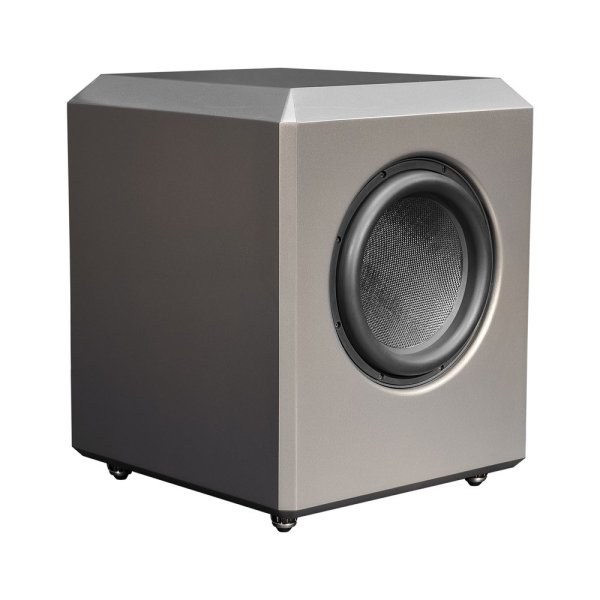 response.
response.
1. As standard subwoofers for augmentation below 30 cycles. In that mode, we like them most in the rear of the room, setting amplitude gain and phase to integrate with our mains.
2. Next, we use them as room node cancellation woofers, always from the rear of the room and in 90% of applications facing the wall for maximum effectiveness.
3. In the fall, we will launch a 4-pack and a 6-pack that can be combined in the stack for both functions, and we believe there will be no finer total bass solution available. Three sizes will be available by early 2025. Still, they are in 12" and 15" sizes, using a vented alignment that offers better pitch definition, speed, and extension than sealed box enclosures.
If you have any questions, feel free to PM me. If I cannot address them technically, I'll send them to Damon for a response.
 response.
response.
Last edited:
My experience as well. PCs and ICs made virtually no difference. I also have 4 subs (all JLA Fathoms). I would encourage all to do some form of blind testing as sometimes we hear what we want to hear.My main audio system includes four subwoofers:
- Two Perlisten receiving signal from a line stage preamplifier via balanced XLR cable
- Two Vandersteen receiving signal from the power amplifier output terminals via speaker cable
For balanced XLR cable, I tried AudioQuest Husky, Morrow Audio SUB4, Belden 1800F, and Mogami W2549 - order is most to least expensive. For speaker cable, I tried Wireworld Equinox 8, Morrow Audio SP4, and Belden 1313A - again, order is most to least expensive. In each case, my overall system sound quality was practically identical.
Regarding power cables, I did not perceive a material difference among Wireworld Electra 7, AudioQuest NRG-4, and stock. I have two 20A electrical circuits dedicated to the subwoofers, which may be a contributing factor.
This is all to say that experimenting with cables for my subwoofers was fun and informative, so it may also be for you.
Hi Lee,
Did Jim have a theory underlying this observation?
I will ask him.
I am a bass aficionado. I want a system that will play with power down to 10Hz. If you have a no holds barred sub system it's expensive. My choice is to run the mains full range independent of the subwoofer. This means that the mains must be extremely rugged. For practical purposes an XVX cannot be over loaded with LF bass no matter how extreme. It is impervious and this is one of the most remarkable qualities of the speaker. The next choice will be to have the subwoofer amplification separate from the sub. In other words the sub becomes a super heavy expensive box. Next is the choice of the box: sealed or ported and the lie of the sub, because subs move. They must be extremely well anchored to the floor.
AQ Wind solid silver balanced IC's 1.5-meter 3K
Wilson ActivXO electronic crossover 5.5K LP only 30 Hz; AQ Hurricane HC power cord 2-meter 2.7K for crossover
AQ Wolf 10% silver 20' balanced subwoofer cable 1.5K
McIntosh 2.1KW Anniversary with 1,720 joules of energy storage 50K
Two AQ Firebird and one Hurricane AQ power cords 17.8K (two HC and one source)
Niagara 5000 power conditioner 5.9K
AQ Dragon HC power cord 5.9K
AQ Redwood 3-meter speaker cable to Thor about 37% sold silver with same double counterspiral geometry as my Wel Signature solid silver main speaker cables to XVX 6.5K
Custom made Thor by Wilson for horizontal lie and 3rd gen X-material 27K, finished on both ends by Wilson
Subwoofer Plinth for Thor custom made by Wilson with Wilson acoustic diodes wt. 150 pounds 4.1K
Total 130K
Total speaker system cost including XVX and Wel Signature speaker cables about 550K
Total subwoofer system weight including amp, plinth, and crossover about 1,200 pounds
Total speaker system weight including XVX about 2,600 pounds
Comment: the original Thor was made by Dave Wilson for the X-2 Alexandria as a replacement for the Wilson XS 750 pound dual 18" woofer subwoofer. It was not designed for the XVX nor was it designed for stereo. It's original crossover was mono so if you wanted to run dual Thors you needed two Wilson crossovers. The Subsonics are the subs intended for the XVX because they are quicker but much less efficient than a Thor and have less LF output. Two Subsonics will about equal one Thor in output. Wilson felt that the specially made custom Thor and Plinth in the intended music position between the XVX would be best for me. I was willing to buy two Subsonics or even a Master Chronosonic, but I had room constraints. I bought them (the XVX and Thor) at the same time. I believe that Wilson made the right choice for me. Wilson was absolutely integral in designing my system. My acoustic diodes for my XVX are specially made by Wilson to give me one extra inch in ceiling clearance.
When the sub becomes an integral part of the system it can create significant problems because many times the signal must pass through the sub crossover which becomes a weak point. REL overcomes this by taking the signal after it leaves the main amp and there may be other ways to work around this, I don't know, but even the REL solution is not ideal. The most elegant way to run a subwoofer system is to have it run LP only and the mains full range, i.e. Dave Wilson's configuration. He knew a lot about subwoofers. In addition, amplification can become an issue with a sealed box subwoofer. Many subs use class D amps and claim to be able to produce enormous amounts of instantaneous power, but can they really? I'll includes some pics. My MC2.1KW will produce 2K real world watts which my Thor can real world handle without overload.
For two Subsonics you will need two monster mono amps of at least 1,100 watts. I would use two 2.1KW's, one for each sub and cables, cords, and power at least on the AQ Firebird level everywhere. The total price would be steep, about twice mine of 130K, around 250K, but still less than a WAMM. But that's what it will require and I would prefer this configuration to a WAMM.
Best
Charles
Charles Updated System: Wilson McIntosh Audioquest
Gear in store scheduled for installation on April 17th: Hi Fi Rose 130RS Network Transport; Samsung 4T internal SSD; Audioquest Wel Signature digital balanced 1-meter IC; Audioquest Diamond 1.5 meter USB cable; Audioquest Dragon 2-meter source power cord; HDMI cable 24’ for music videos
Amps: McIntosh: MC3500MKII (2); MC1.25KW (2); MC2.1KW An
Preamp: C-12000 An
Sources: MCD12000 An; MVP881; MVP851; MR87; Marantz 510LV; Lenovo Yoga laptop
Speakers: Wilson Chronosonic XVX
Sub-Woofer: Wilson Thor’s Hammer; Wilson ActivXO Stereo Electronic Crossover
Cables Main System AQ: WEL Signature speaker cables; 24’ balanced IC; balanced 1-meter Dragon IC ; WEL Signature digital, Coffee digital coaxial cables; Diamond optical (2); Diamond USB; Dragon (5 HC, 3 source cords); Thunder & Monsoon power cords
Cables Subwoofer System AQ: Redwood speaker cable; Wolf balanced subwoofer IC; Wind balanced IC to ActivXO; Hurricane HC; Firebird HC; Firebird Source; Dragon HC, power cords
Power Conditioners: AQ Niagara 7000; Niagara 5000 (3); (4) dedicated 20-amp lines.
Isolation: Wilson Pedestals; Bassocontinuo McIntosh Ultra Feet; X-material plinth
Cabinet: Double Custom Woodwork & Design (CWD)
Acoustic Treatments: Room and Echo Tunes
AQ Wind solid silver balanced IC's 1.5-meter 3K
Wilson ActivXO electronic crossover 5.5K LP only 30 Hz; AQ Hurricane HC power cord 2-meter 2.7K for crossover
AQ Wolf 10% silver 20' balanced subwoofer cable 1.5K
McIntosh 2.1KW Anniversary with 1,720 joules of energy storage 50K
Two AQ Firebird and one Hurricane AQ power cords 17.8K (two HC and one source)
Niagara 5000 power conditioner 5.9K
AQ Dragon HC power cord 5.9K
AQ Redwood 3-meter speaker cable to Thor about 37% sold silver with same double counterspiral geometry as my Wel Signature solid silver main speaker cables to XVX 6.5K
Custom made Thor by Wilson for horizontal lie and 3rd gen X-material 27K, finished on both ends by Wilson
Subwoofer Plinth for Thor custom made by Wilson with Wilson acoustic diodes wt. 150 pounds 4.1K
Total 130K
Total speaker system cost including XVX and Wel Signature speaker cables about 550K
Total subwoofer system weight including amp, plinth, and crossover about 1,200 pounds
Total speaker system weight including XVX about 2,600 pounds
Comment: the original Thor was made by Dave Wilson for the X-2 Alexandria as a replacement for the Wilson XS 750 pound dual 18" woofer subwoofer. It was not designed for the XVX nor was it designed for stereo. It's original crossover was mono so if you wanted to run dual Thors you needed two Wilson crossovers. The Subsonics are the subs intended for the XVX because they are quicker but much less efficient than a Thor and have less LF output. Two Subsonics will about equal one Thor in output. Wilson felt that the specially made custom Thor and Plinth in the intended music position between the XVX would be best for me. I was willing to buy two Subsonics or even a Master Chronosonic, but I had room constraints. I bought them (the XVX and Thor) at the same time. I believe that Wilson made the right choice for me. Wilson was absolutely integral in designing my system. My acoustic diodes for my XVX are specially made by Wilson to give me one extra inch in ceiling clearance.
When the sub becomes an integral part of the system it can create significant problems because many times the signal must pass through the sub crossover which becomes a weak point. REL overcomes this by taking the signal after it leaves the main amp and there may be other ways to work around this, I don't know, but even the REL solution is not ideal. The most elegant way to run a subwoofer system is to have it run LP only and the mains full range, i.e. Dave Wilson's configuration. He knew a lot about subwoofers. In addition, amplification can become an issue with a sealed box subwoofer. Many subs use class D amps and claim to be able to produce enormous amounts of instantaneous power, but can they really? I'll includes some pics. My MC2.1KW will produce 2K real world watts which my Thor can real world handle without overload.
For two Subsonics you will need two monster mono amps of at least 1,100 watts. I would use two 2.1KW's, one for each sub and cables, cords, and power at least on the AQ Firebird level everywhere. The total price would be steep, about twice mine of 130K, around 250K, but still less than a WAMM. But that's what it will require and I would prefer this configuration to a WAMM.
Best
Charles
Charles Updated System: Wilson McIntosh Audioquest
Gear in store scheduled for installation on April 17th: Hi Fi Rose 130RS Network Transport; Samsung 4T internal SSD; Audioquest Wel Signature digital balanced 1-meter IC; Audioquest Diamond 1.5 meter USB cable; Audioquest Dragon 2-meter source power cord; HDMI cable 24’ for music videos
Amps: McIntosh: MC3500MKII (2); MC1.25KW (2); MC2.1KW An
Preamp: C-12000 An
Sources: MCD12000 An; MVP881; MVP851; MR87; Marantz 510LV; Lenovo Yoga laptop
Speakers: Wilson Chronosonic XVX
Sub-Woofer: Wilson Thor’s Hammer; Wilson ActivXO Stereo Electronic Crossover
Cables Main System AQ: WEL Signature speaker cables; 24’ balanced IC; balanced 1-meter Dragon IC ; WEL Signature digital, Coffee digital coaxial cables; Diamond optical (2); Diamond USB; Dragon (5 HC, 3 source cords); Thunder & Monsoon power cords
Cables Subwoofer System AQ: Redwood speaker cable; Wolf balanced subwoofer IC; Wind balanced IC to ActivXO; Hurricane HC; Firebird HC; Firebird Source; Dragon HC, power cords
Power Conditioners: AQ Niagara 7000; Niagara 5000 (3); (4) dedicated 20-amp lines.
Isolation: Wilson Pedestals; Bassocontinuo McIntosh Ultra Feet; X-material plinth
Cabinet: Double Custom Woodwork & Design (CWD)
Acoustic Treatments: Room and Echo Tunes
Last edited:
Pics
Attachments
-
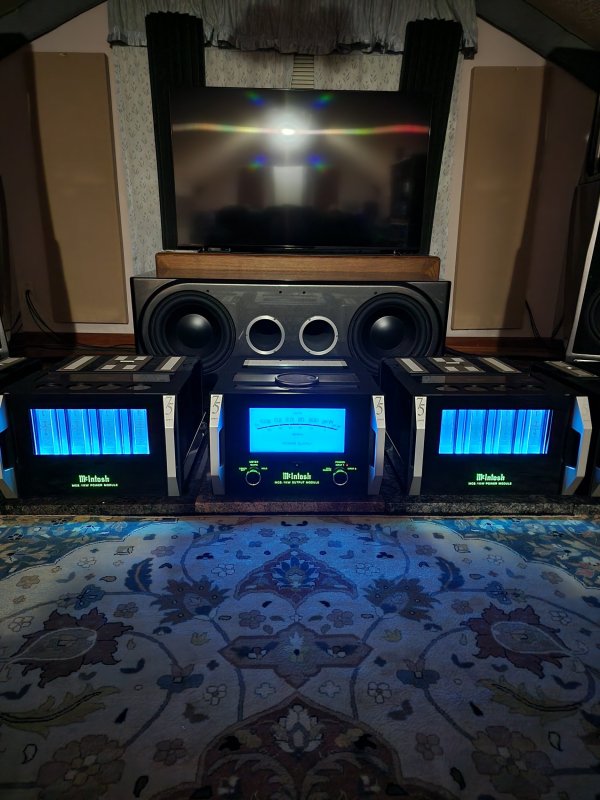 20240731_015659.jpg557.6 KB · Views: 15
20240731_015659.jpg557.6 KB · Views: 15 -
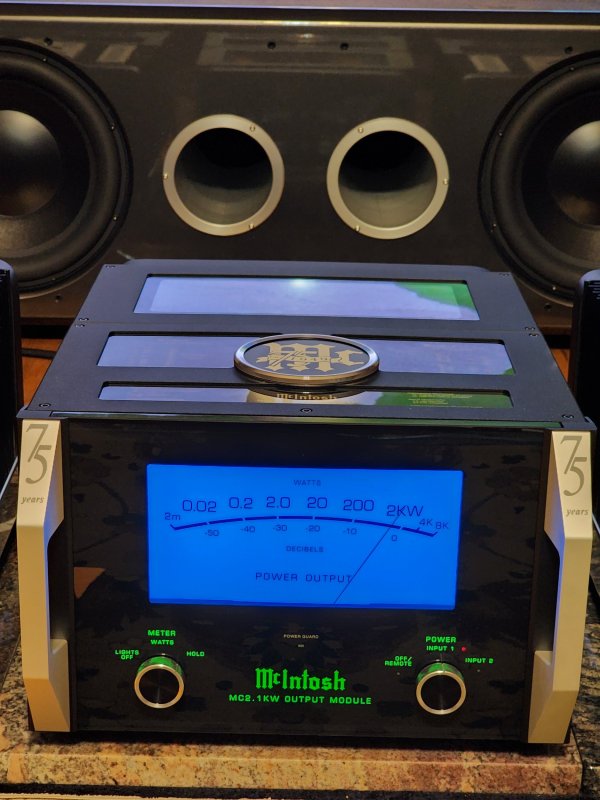 20240831_125229.jpg529.1 KB · Views: 14
20240831_125229.jpg529.1 KB · Views: 14 -
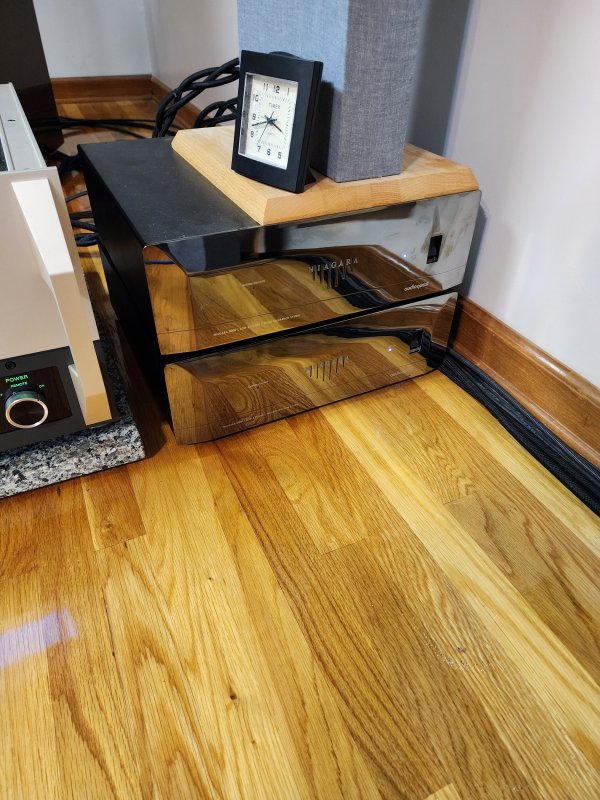 20241116_034341.jpg927.2 KB · Views: 13
20241116_034341.jpg927.2 KB · Views: 13 -
 20240707_145050.jpg477.4 KB · Views: 13
20240707_145050.jpg477.4 KB · Views: 13 -
 20250213_125513.jpg273.6 KB · Views: 13
20250213_125513.jpg273.6 KB · Views: 13 -
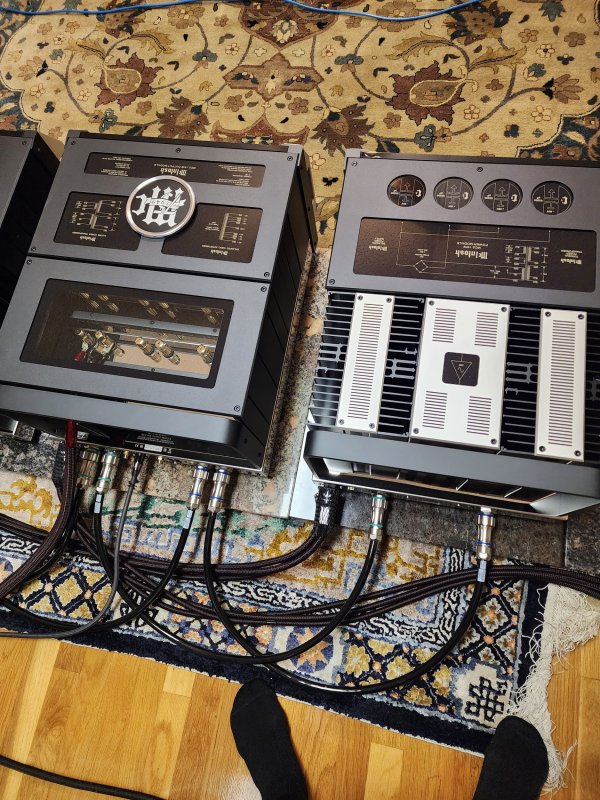 20250210_124434.jpg1.3 MB · Views: 12
20250210_124434.jpg1.3 MB · Views: 12 -
 20250210_124426.jpg1.4 MB · Views: 13
20250210_124426.jpg1.4 MB · Views: 13 -
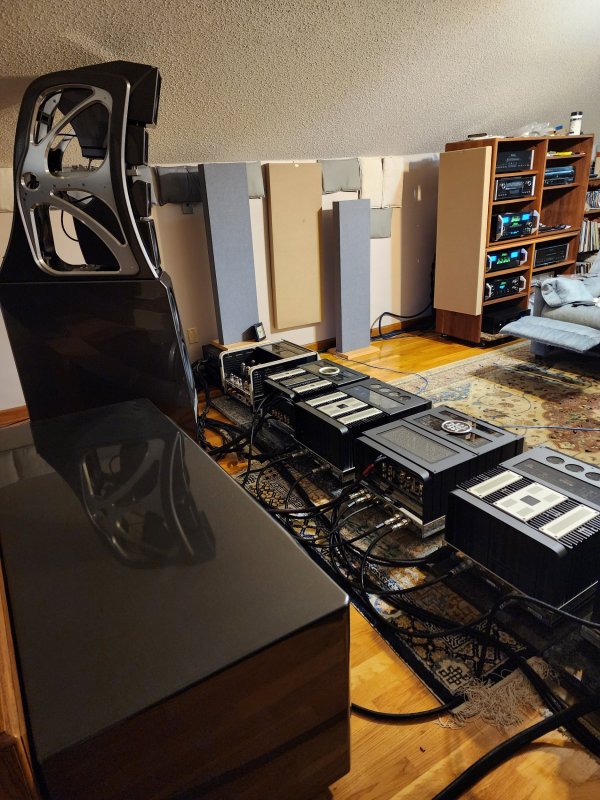 20240707_145145.jpg916.2 KB · Views: 14
20240707_145145.jpg916.2 KB · Views: 14
Any speaker including subwoofers can be overloaded, all motor structures and drivers have their limit. Speakers that have very high limits commonly have separate bass towers or a series of very large drivers (see Vivid Moya, EA MM7, YG acoustic tower model, Magico M9, Rockport Arrakis, etc).I am a bass aficionado. I want a system that will play with power down to 10Hz. If you have a no holds barred sub system it's expensive. My choice is to run the mains full range independent of the subwoofer. This means that the mains must be extremely rugged. For practical purposes an XVX cannot be over loaded with LF bass no matter how extreme. It is impervious and this is one of the most remarkable qualities of the speaker.
Specific to the XVX, the bass drivers aren't overly large or special employing ~10" and ~12" paper drivers, seemingly with no extreme Xmax, even Wilson augments them with subs.
I'm sure they're quite good speakers but all reasonably sized woofers have their limits.
sbo6, I know that it may be difficult to believe, but over the years I have collected a tremendous number of bass blasts in my music collection, and I appreciate your comment, but take the M9 for example. I would take a bet that the XVX would easily, and I mean easily best it as far as overload resistance. I don't understand why, but it is extremely impervious to overload. On heavy bass, I mean really heavy bass, the woofers hardly even move, even when you are a foot away trying to see at least a little movement. This is simply a fact. I asked Robert Harley if he had ever seen his woofers move (excursion) and the answer was no. I can't speak for other massive speakers and nothing is impossible, in the real world, with any kind of bass blast or extremely heavy low frequency transient, the XVX is essentially indestructible, 100%. I don't think it has much to do with the size of the woofers or the surrounds. The woofers simply have almost zero excursion for all intents and purposes. Perhaps someone might have an explanation. I can attest that without the Thor the XVX will produce amazing bass. There's nothing malfunctioning.
This is why you can run it full range. There is no subwoofer including two Thors, that can keep up with an XVX. You can have any subs you like, run the XVX full range, and never worry about overload. The subwoofer will go long before the XVX.
This is why you can run it full range. There is no subwoofer including two Thors, that can keep up with an XVX. You can have any subs you like, run the XVX full range, and never worry about overload. The subwoofer will go long before the XVX.
Similar threads
- Replies
- 1
- Views
- 1K
- Replies
- 0
- Views
- 2K
- Replies
- 3
- Views
- 965
- Replies
- 16
- Views
- 1K
- Replies
- 2
- Views
- 2K
| Steve Williams Site Founder | Site Owner | Administrator | Ron Resnick Site Owner | Administrator | Julian (The Fixer) Website Build | Marketing Managersing |






